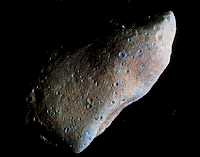An interesting asteroid report last week has made we consider a Hybrid NEO prospecting/research mission:
A few thoughts on the timing challenges of a prospecting mission of any kind:
- One potential market for the information gathered about the target asteroid(s) is to sell the data to those interested in mining such asteroids.
- Most NEO’s are in orbits whose paths cross infrequently with earth’s orbit.
- Most “low cost” mining efforts would require a near earth asteroid to pass by earth at least two times – one pass for the prospector to prospect (sending back data) and a second pass to mount a mining expedition. Without two passes would require the venture to combine prospecting and mining into a single mission. I believe this approach to be too high risk for an investor-led venture.
- Finding NEOs that return frequently enough to earth to attract investment dollar for a mining mission (double orbit missions) may be difficult.
- And the prospector company (the company that flew to multiple NEOs in search of data about asteroid composition, etc.) will have a hard time selling their data if they have to wait for the NEO to approach a second time.
- For example: Asteroid 2006 RH120 at its closest distance from earth could be reached with only 3.8km/sec of delta-v. According to JPL, Asteroid 2006 RH120 last approached earth on 14 June 2007 and won’t return again until 29 Oct 2028. If your prospecting mission had gathered data on 2006 RH120, the scientific community might purchase the data gathered (yay), but commercial groups would not if the commercial ventures had to wait 20+ years to turn that data into profits.
- Some NEOs return to earth more frequently than this example, but it illustrates a principle – prime targets for commercial NEO prospecting missions would combine a low delta-v to reach and frequent return trips to earth.
Enter 2010 SO16.
2010 SO16 is unlike most NEOs and at 7.6 km/sec of delta-v to reach, it may offer an attractive target for a NEO prospecting mission. Some quick facts:
- Located in a similar orbit to earth’s – just 60% ahead
- ~50x the distance to the moon
- Very stable orbit – been there a long time!
- May be a part of the theorized objects located at the triangular equilibrium points 60 degrees ahead of and behind the Earth in its orbit
- Scientists may find such an object interesting because as the article put it, “If they [triangular equilibrium objects] do exist, they may represent relic material from the formation of Earth, Moon and the other inner planets”
- 200-400 meters across - plenty of rock to prospect.
Why Prospect Asteroid 2010 SO16?
- Pretty close to earth – so you can prospect the asteroid
- Always pretty close to earth – so other could mine the asteroid if they determine it profitable to do so. This makes your prospecting data more valuable too.
- Valuable as an earth observation point? Perhaps?
- Valuable to watch for NEOs? (not sure on this point – need some engineers out there to help me). The alternative is to send a probe to Venus to watch earth – which would be easier or more valuable?
- If 2010 SO16 is actually ejecta from earth/moon formation as some scientists have theorized, this asteroid may hold significant scientific value.
- If 2010 SO16 is actually apart of other objects located close by, once there, additional objects may be close by to prospect as well.
Commercial value. Scientific value. Profitable?


No comments:
Post a Comment